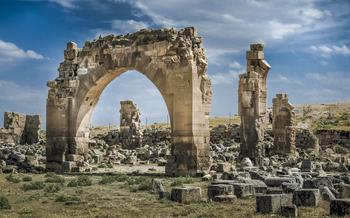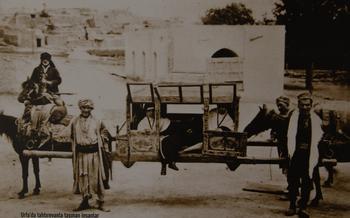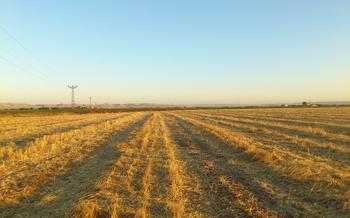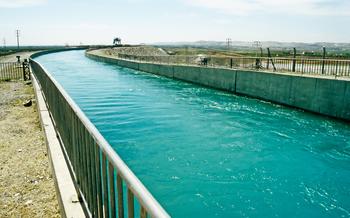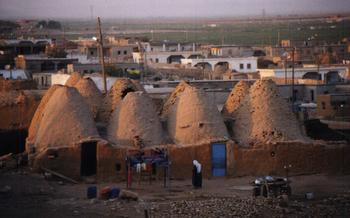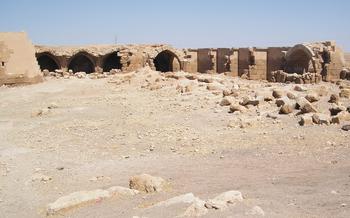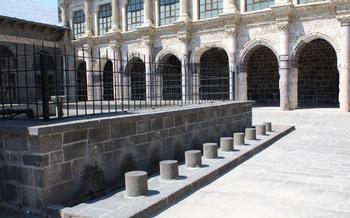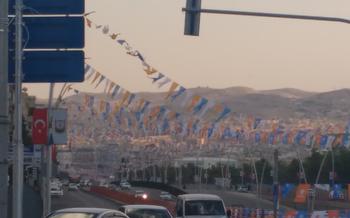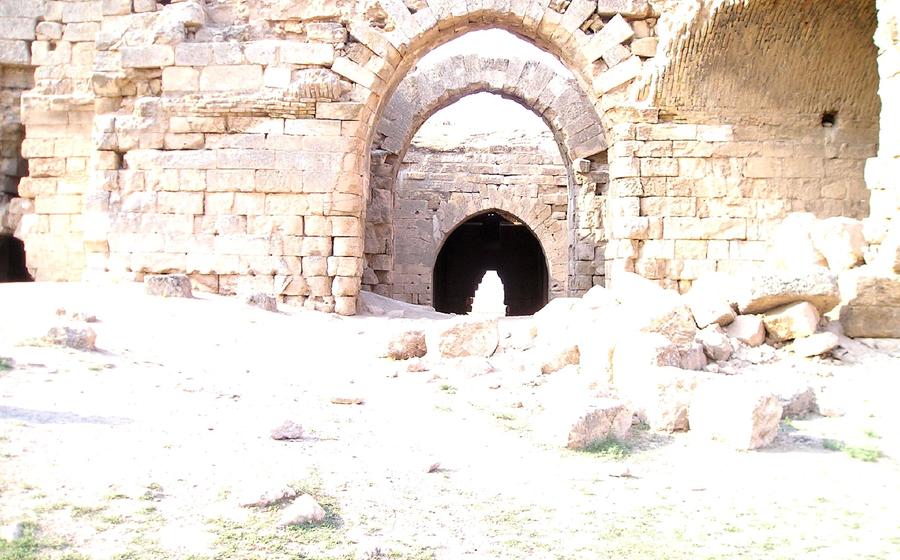
Harran Citadel
- The Antiquity of Harran
- The Enigmatic Beehive Houses
- The Great Mosque of Harran
- The Remains of the Ancient City Walls
- The Archaeological Museum of Şanlıurfa
- The Vibrant Bazaars of Harran
- The Harran Plain and Its Agricultural Heritage
- The Legendary Pools of Harran
- The Influence of the Sabians
- The Culinary Delights of Harran
- The Harran Folk Museum
- The Festival of Abraham
- The Surrounding Natural Landscapes
- Accommodation Options in Harran
- Insider Tip: Hidden Gems of Harran
The Antiquity of Harran
The ancient city of Harran, located in southeastern Turkey, holds a significant place in the annals of human history. Its origins can be traced back to the 3rd millennium BC, making it one of the oldest continuously inhabited cities in the world. Harran played a pivotal role in various civilizations, serving as a major trading hub on the Silk Road and a religious center for several cultures.
Mentioned in both the Bible and the Quran, Harran is steeped in religious significance. According to the biblical narrative, it was the birthplace of the patriarch Abraham, who left the city to journey to the land of Canaan. In Islamic tradition, Harran is revered as the place where the prophet Ibrahim (Abraham) built a mosque and disseminated the teachings of monotheism.
The city's rich past is further evidenced by the numerous architectural remains and artifacts that have been discovered within its walls. Excavations have unearthed the ruins of ancient temples, palaces, and fortifications, providing glimpses into the grandeur and sophistication of Harran's bygone era. These remnants serve as tangible proof of the city's enduring legacy and its contributions to the cultural heritage of the region.
The Enigmatic Beehive Houses
Harran is renowned for its extraordinary beehive houses, a unique architectural style that has captivated the imagination of travelers and historians alike. These peculiar structures, resembling giant beehives, are constructed from mud bricks and feature a distinctive rounded shape with a narrow entrance. Their construction technique involves stacking mud bricks in a corbelled arch, creating a self-supporting dome without the need for internal support beams.
The beehive houses were designed to adapt to the region's harsh climate, providing insulation from extreme temperatures and protection from strong winds. Their rounded shape allows air to circulate efficiently, maintaining a comfortable indoor temperature during both summer and winter. Additionally, the narrow entrances help to conserve heat and keep out dust and sand.
Beyond their practical functionality, the beehive houses hold cultural significance, deeply rooted in the local lifestyle and traditions. Traditionally, each family occupied a single beehive house, with separate structures for cooking, storage, and livestock. The houses were often decorated with intricate patterns and designs, reflecting the creativity and artistry of the local people.
One of the most fascinating aspects of the beehive houses is the enduring mystery surrounding their origin. While their exact history remains shrouded in obscurity, some theories suggest that they may have been influenced by ancient Mesopotamian architecture or nomadic tent structures. Others believe that their design evolved in response to the unique environmental conditions of the Harran Plain.
To this day, the beehive houses continue to be a symbol of Harran's rich cultural heritage. While many of these structures have been abandoned and are in various states of disrepair, a number of them have been restored and are now used as museums, cafes, and guesthouses, offering visitors a glimpse into the unique lifestyle of the past.
The Great Mosque of Harran
The Great Mosque of Harran, also known as the Ulu Cami, stands as a testament to the city's rich Islamic heritage. Constructed in the 8th century during the Umayyad dynasty, it is among the oldest mosques in the world. Its architectural features are a blend of Islamic and local influences, showcasing a rectangular prayer hall adorned with rows of arches supported by massive columns. The mosque's minaret, a later addition, is a striking landmark visible from afar.
During my visit, I was particularly captivated by the mosque's serene atmosphere. As I stepped inside, the echoes of my footsteps reverberated through the vast prayer hall, creating a sense of awe and tranquility. The intricate carvings and calligraphy that adorned the walls and arches told stories of faith and devotion. I couldn't help but marvel at the mosque's enduring legacy, having witnessed countless prayers, celebrations, and moments of contemplation over the centuries.
The Great Mosque of Harran played a pivotal role in the spread of Islam in the region. As one of the earliest centers of Islamic learning and scholarship, it attracted scholars and students from far and wide. The mosque's influence extended beyond religious matters, as it served as a community hub where people gathered for social, educational, and cultural activities.
Visiting the Great Mosque of Harran was a profound experience that left a lasting impression. It is a place where history, architecture, and spirituality intertwine, offering a glimpse into the deep-rooted Islamic heritage of this ancient city.
The Remains of the Ancient City Walls
The city walls of Harran stand as a testament to the city's rich history and strategic importance. Constructed in the 8th century BC, these massive fortifications once encircled the entire city, providing protection from invaders and ensuring the safety of its inhabitants. Built using mud bricks, the walls were reinforced with stone towers and gateways, creating an impenetrable barrier that withstood numerous sieges and attacks throughout the centuries.
Although only portions of the walls remain today, their grandeur and historical significance are undeniable. Visitors can explore the surviving sections, marveling at the intricate construction techniques and imagining the bustling life that once took place within these ancient boundaries. Ongoing preservation efforts aim to protect and restore these remnants of Harran's glorious past, ensuring that future generations can appreciate their enduring legacy.
The Archaeological Museum of Şanlıurfa
The Archaeological Museum of Şanlıurfa, situated in the heart of the city, houses a remarkable collection of artifacts and exhibits that chronicle the rich cultural heritage of Harran and the surrounding region. It is a treasure trove for history enthusiasts, archaeologists, and anyone seeking to delve deeper into the ancient civilizations that once flourished in this land.
The museum's exhibits span various historical periods, from prehistoric times to the Islamic era. Visitors can marvel at the intricate stone carvings, pottery, and bronze sculptures that provide glimpses into the artistic prowess of ancient civilizations. A particularly noteworthy exhibit is the collection of clay tablets inscribed with cuneiform script, offering insights into the written communication and administrative systems of the region's earliest inhabitants.
One of the museum's highlights is the collection of artifacts from the ancient city of Harran. These include intricately carved architectural fragments, pottery vessels, and jewelry, all of which provide valuable clues about the daily lives, customs, and beliefs of the people who once called Harran home. The museum also houses a collection of artifacts related to the Sabian community, an ancient religious group that played a significant role in Harran's history.
A visit to the Archaeological Museum of Şanlıurfa is a must for anyone interested in understanding the rich cultural heritage of the region. Its well-curated exhibits, combined with informative displays and knowledgeable staff, make it an immersive and educational experience that brings the past to life.
The Vibrant Bazaars of Harran
In the heart of Harran, the vibrant bazaars come alive with a symphony of colors, sounds, and aromas. These bustling marketplaces are a testament to the city's rich trading history, where merchants from distant lands once converged to exchange goods and ideas. Immerse yourself in the labyrinthine alleys, where vendors display their wares with pride. From intricately woven carpets and hand-embroidered textiles to glistening copperware and aromatic spices, the bazaars offer a treasure trove of unique souvenirs and local products.
Haggling is an integral part of the shopping experience in Harran. Engage with the friendly vendors, who are always willing to strike a bargain. With a smile and a few Turkish phrases, you can secure the best prices while also supporting the local economy. Discover the art of traditional craftsmanship as you witness artisans creating exquisite pottery, intricate jewelry, and other handmade goods right before your eyes.
As you wander through the bazaars, don't forget to sample the local delicacies. From freshly baked bread and gözleme (savory filled flatbread) to sweet pastries and aromatic Turkish coffee, the food stalls offer a tantalizing array of culinary delights. Indulge in the vibrant atmosphere and let the spirit of Harran captivate your senses as you explore its vibrant bazaars.
The Harran Plain and Its Agricultural Heritage
Harran, renowned for its rich agricultural heritage, boasts a fertile plain that has been cultivated for centuries. The region's soil, enriched by the waters of the Euphrates River, provides an ideal environment for a diverse array of crops. Traditional farming practices, passed down through generations, continue to shape the agricultural landscape.
Wheat, the backbone of the local economy, is extensively cultivated in the Harran Plain. Farmers employ traditional techniques, such as dry farming and crop rotation, to optimize yields. Lentils, chickpeas, and barley are also prominent crops, adding variety to the agricultural tapestry.
Water management plays a crucial role in sustaining Harran's agricultural productivity. The region's intricate network of canals and irrigation systems, some dating back centuries, ensures a reliable water supply for crops. Farmers skillfully manage water distribution, adapting to changing weather patterns and seasonal fluctuations.
The culinary traditions of Harran are deeply intertwined with its agricultural heritage. Local cuisine showcases the region's fresh produce, with dishes that celebrate the flavors of the land. Harran's signature dish, "kısır," a cracked wheat salad with vegetables and herbs, is a testament to the region's agricultural bounty.
Visiting the Harran Plain offers a unique opportunity to witness traditional farming practices and experience the region's agricultural heritage firsthand. Whether strolling through fields of golden wheat, marveling at the intricate irrigation systems, or savoring the flavors of local cuisine, visitors can immerse themselves in the rich agricultural tapestry of Harran.
The Legendary Pools of Harran
Amidst the ancient ruins of Harran, a series of enigmatic pools holds a captivating allure, steeped in history and spirituality. These pools, once central to the city's religious rituals and daily life, bear witness to the ingenuity and resilience of its people.
In ancient times, the pools served as sacred bathing places for the Sabians, a Gnostic sect that revered John the Baptist. They believed that immersion in the pools would purify their souls and connect them with the divine. The pools were also an integral part of the city's water management system, providing a vital source of water for irrigation and daily use.
Over time, the pools fell into disrepair and neglect, their once-pristine waters receding. However, in recent years, there has been a growing effort to restore and revitalize these ancient landmarks. Archaeological excavations have uncovered new insights into their construction and significance, and restoration projects are underway to revive their original splendor.
Today, visitors can explore the pools and marvel at their enduring legacy. The largest of the pools, known as the "Great Pool," measures an impressive 20 meters in diameter and is surrounded by a series of smaller pools. The stone steps leading down to the water's edge evoke a sense of reverence and tranquility, inviting visitors to pause and reflect on the rich history that unfolds before them.
As the sun sets over the Harran Plain, casting a golden glow on the ancient ruins, the pools shimmer with an otherworldly aura. Their waters, once a source of life and purification, continue to captivate and inspire, serving as a potent reminder of the enduring spirit of Harran.
The Influence of the Sabians
The city of Harran has a long and intriguing history, and one of its most notable features is its association with the Sabians. The Sabians were an ancient religious group who originated in Mesopotamia and were known for their unique beliefs and practices. They were monotheistic, believing in a single, supreme God, and they practiced a form of astrology and star worship. The Sabians also had a strong belief in reincarnation and the immortality of the soul.
The Sabians were present in Harran for centuries, and their influence can still be seen in the city today. The Great Mosque of Harran, for example, is believed to have been built on the site of a former Sabian temple. The mosque's unique architectural features, such as its square minaret and its unusual layout, are thought to reflect Sabian influences.
The Sabians eventually disappeared from Harran, but their legacy lives on. The city's rich cultural heritage is a testament to the influence of this ancient and enigmatic people.
The Culinary Delights of Harran
Indulge in the tantalizing flavors of Harran's cuisine, a harmonious blend of tradition and local ingredients. Savor the aromatic isot, a spicy pepper paste that adds a fiery kick to many dishes. Experience the melt-in-your-mouth goodness of künefe, a crispy shredded phyllo pastry filled with melted cheese and drizzled with sweet syrup. Don't miss the chance to try borani, a hearty dish of yogurt and sun-dried eggplant, a testament to Harran's agricultural heritage. For a taste of local bread, try the freshly baked sac ekmeği, perfect for dipping in olive oil or accompanying grilled meats.
For a truly authentic Harran dining experience, venture into the vibrant local markets, where you can find an array of fresh produce, spices, and traditional delicacies. Engage with the friendly vendors, who will gladly share their culinary knowledge and help you discover hidden gems. Be sure to sample the freshly made lahmacun, a thin, crispy flatbread topped with minced meat and vegetables, or indulge in the sweet indulgence of şıllık tatlısı, a delicate pastry filled with walnuts and honey.
Harran's culinary scene is a testament to the city's rich history and cultural influences. From savory dishes that pack a punch to sweet treats that tantalize the taste buds, there's something to satisfy every palate. Embrace the flavors of Harran and embark on a culinary adventure that will leave you craving for more.
The Harran Folk Museum
The Harran Folk Museum stands as a testament to the rich cultural heritage of the region, offering visitors a glimpse into the traditional customs, crafts, and lifestyles of Harran's people. Within its walls, a treasure trove of artifacts awaits, encompassing intricately woven carpets, gleaming copperware, and ornate jewelry, each piece a testament to the skill and artistry of local artisans.
Through interactive exhibits and informative displays, the museum narrates the story of Harran's past, highlighting significant historical events and the contributions of its diverse communities. Visitors are transported back in time as they witness the evolution of traditional farming practices, marvel at the intricacies of ancient irrigation systems, and gain insights into the daily lives of Harran's inhabitants throughout the ages.
The Harran Folk Museum is not merely a repository of artifacts; it is a vibrant hub where the past comes alive, inviting visitors to engage with the living traditions of the region. Workshops and demonstrations offer hands-on experiences, allowing visitors to try their hand at traditional crafts, learn the art of carpet weaving, or create their own pottery.
As you wander through the museum's exhibits, take the time to observe the intricate details and craftsmanship of each artifact. Each piece tells a story, revealing the ingenuity and creativity of Harran's people. Immerse yourself in the stories and traditions that have shaped this unique and captivating region.
The Festival of Abraham
The Festival of Abraham, also known as the Harran Culture and Art Festival, is a significant annual event that celebrates the city's rich cultural heritage and its connection to the biblical figure of Abraham. The festival typically takes place in October and draws visitors from all over Turkey and beyond.
During the festival, the streets of Harran come alive with a vibrant display of traditional music, dance, and art. Local craftsmen and artisans showcase their skills, demonstrating the ancient crafts and techniques that have been passed down through generations. Visitors can immerse themselves in the local culture by participating in traditional games, trying their hand at traditional crafts, and savoring delicious local cuisine.
One of the highlights of the festival is the reenactment of Abraham's journey from Ur to Harran, which is performed by local actors in traditional costumes. The procession winds its way through the city, accompanied by music and chanting, creating a truly immersive and unforgettable experience.
The Festival of Abraham is more than just a celebration; it is a testament to the enduring legacy of Harran's past and its vibrant present. It provides a unique opportunity for visitors to experience the rich cultural heritage of this ancient city and to connect with the local community in a meaningful way.
The Surrounding Natural Landscapes
Beyond the city's cultural treasures, Harran is also blessed with a diverse natural landscape, inviting outdoor enthusiasts and nature lovers to explore its hidden gems. The Harran Plain, stretching for miles in every direction, offers a unique opportunity to immerse oneself in the region's agricultural heritage. Visitors can witness traditional farming practices, marvel at the vast fields of crops, and learn about the region's intricate irrigation systems.
For those seeking adventure, the surrounding hills and valleys provide ample opportunities for hiking, camping, and birdwatching. The Harran Mountains, rising majestically in the distance, offer challenging trails for experienced hikers, while the lush valleys are home to a diverse array of bird species, making them a haven for birdwatchers.
The region's unique flora and fauna add to its natural charm. Visitors can spot colorful wildflowers, aromatic herbs, and rare bird species that call this region their home. It's important to practice responsible and sustainable tourism when exploring these natural areas, respecting the environment and minimizing one's impact on the delicate ecosystem.
Accommodation Options in Harran
When planning a trip to Harran, finding suitable accommodation is crucial. The city offers a range of options to cater to different budgets and preferences. Traditional guesthouses, known as "han," provide a unique opportunity to experience local hospitality and immerse yourself in the city's rich culture. These guesthouses often feature charming architecture and offer basic amenities, ensuring a comfortable stay.
For those seeking a more modern experience, several hotels are available in Harran, ranging from budget-friendly options to luxurious establishments. These hotels offer contemporary amenities and facilities, including comfortable rooms, en-suite bathrooms, and sometimes even swimming pools and fitness centers.
To ensure a hassle-free stay, it is advisable to book your accommodation in advance, especially during peak tourist seasons. Online booking platforms and local travel agencies can assist in finding the best deals and securing your preferred choice.
If you're seeking a truly authentic experience, consider staying at one of the local guesthouses. The warm hospitality of the Harran people, combined with the charm of traditional architecture, will make your stay truly memorable.
Insider Tip: Hidden Gems of Harran
Beyond the main tourist attractions, Harran holds secret treasures waiting to be discovered. One such gem is the Harran Mosaic Museum, housing a remarkable collection of ancient mosaics depicting scenes from mythology, daily life, and religious ceremonies. The intricate craftsmanship and vibrant colors offer a glimpse into the artistic heritage of the region.
Another hidden gem is the Sabian Temple, a sacred site for the ancient Sabian community. Although no longer in use, the temple's well-preserved ruins provide a tangible connection to Harran's unique religious past. Visitors can explore the temple's chambers and marvel at its architectural details, gaining insights into the beliefs and practices of the Sabians.
For a taste of authentic Harran cuisine, venture into the local bakeries to sample freshly baked pide and katmer, traditional flatbreads filled with savory or sweet ingredients. These culinary delights are a testament to Harran's rich culinary traditions and are best enjoyed with a cup of Turkish tea.
To delve deeper into the local culture, interact with the friendly locals who are eager to share their stories and traditions. Visit the Harran Cultural Center, where you can learn about traditional crafts, attend workshops, and participate in cultural events. Engaging with the locals provides a unique and immersive experience, allowing you to gain a deeper understanding of Harran's vibrant heritage.
